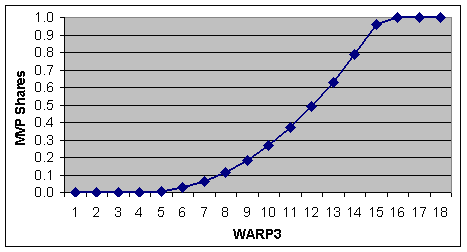Let me be fully honest here: I don’t care about the MVP debates. Oh sure, when you’re like 17, and the topic comes up, it’s a perfect opportunity to spout your newfound wisdom:
Bill: “Dude, Dante Bichette rocks!”
Ted: “No way, dude! Barry Larkin rules!”
Bill: “Dante!”
Ted: “Barry!”
Nate: “Actually, considering his value relative to his position and accounting for park effects, I think you’d have to give the nod to Mike Piazza over either of the aforementioned candidates. Sure, you’d have to consider Greg Maddux here too, the BBWAA’s traditional bias against starting pitching notwithstanding. But Maddux has been assisted considerably by his defense, and in full consideration of the facts, my tally would be with Piazza.”
Bill, Ted: “Dude?”
Everyone has his own standards when it comes to MVP voting, ranging from Player Rated Highest by Win Shares (PRHWS) to My Favorite Yankee (MFY). Most debates about the MVP turn out to be pointless because they devolve into reiterating those standards over and over, rather than actually applying them. And people aren’t likely to change their standards in the heat of an argument.
So instead, I’ve become something of an existentialist when it comes to MVP voting: Pick whatever standards you like, just make sure you apply them consistently. If you don’t think starting pitchers deserve consideration for the top spot on your ballot…don’t vote for one of them for second. Same goes if you only want to consider players on contending teams. We can debate semantics all day, but the fact is that the voting standards outlined on the official ballot are sufficiently vague so as to permit multiple interpretations. And that’s OK.
As an analyst and would-be cultural critic, though, I am interested in looking at the nature of people’s biases–what are they, and how do they arise? Note the distinction here: I’m fascinated by the fact that Kenny G has sold over 17 million records. That doesn’t mean that I want to get in a debate with one of his aficionados on G versus Coltrane, et al., and it certainly doesn’t mean that I want to listen to one of his records. But, man, if I could decipher why 17 million Americans bought Kenny G records, I think I’d really be onto something.
So let’s take a look at the history of the MVP balloting, comparing the actual results with what might have occurred if the voters had applied an unyieldingly objective standard. In the subjective corner, we have Award Shares–simply the number of points that a player receives in the balloting divided by the total possible, so a unanimous winner has 1.00 Award Shares–and in the objective corner, we have Clay Davenport’s WARP3 scores.
So you take WARP3 as your independent variable, Award Shares as your dependent variable, add cilantro, garlic, and salt, throw ’em into a blender, and come up with the following regression equation…
I’m not going to publish the regression equation. It’s something of a mess, requiring a combination of several different variants of WARP3 (WARP3 squared, the log of WARP3, and so forth), which would bore some of you and infuriate others on account of its inelegance. Fortunately, the equation produces a pretty looking graph:

A player will almost never receive consideration for the MVP award if he has a WARP3 of 5 or less; yeah, the voters have made their share of eccentric choices, but they don’t miss by that much. A player’s share of the MVP votes then increases exponentially with his WARP until he reaches a WARP3 of around 15, giving him one of the all-time greatest seasons, at which point he’ll win unanimously and there’s no further for him to go–we can’t give Barry Bonds two MVP awards apiece for his 2001 and 2002 campaigns, even though he probably deserves them. Following is the same information in tabular form: MVP’ is predicted award shares.
WARP3 MVP' ------------ 0 0.00 1 0.00 2 0.00 3 0.00 4 0.00 5 0.01 6 0.03 7 0.06 8 0.12 9 0.18 10 0.27 11 0.37 12 0.49 13 0.63 14 0.79 15 0.96 16 1.00 17 1.00 18 1.00
If we look at all elections since 1931, WARP3 alone explains almost exactly half of the MVP balloting for position players. Without anything to compare it to, and in consideration of the fact that voters from previous eras didn’t have anything like WARP3 to work with, I don’t know whether that’s an impressive figure or not, but I kind of like the idea that the voting is half objective and half subjective. Intuitively, that seems about right.
Thank you for reading
This is a free article. If you enjoyed it, consider subscribing to Baseball Prospectus. Subscriptions support ongoing public baseball research and analysis in an increasingly proprietary environment.
Subscribe now